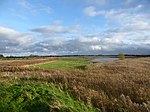Hersden
City of CanterburyCivil parishes in KentMining communities in EnglandVillages in Kent

Hersden is a village east of Canterbury in Kent, South East England. It was established as a planned coalmining village in the 1920s and is on the A28 road between Canterbury and the Isle of Thanet. Work in the Kent Coalfield was the main source of employment in the village until the closure of the Kent colliery in the 1980s. The parish was formed on 1 April 2019 from parts of Sturry, Chislet and Westbere. The Ashford to Ramsgate railway line runs through the parish to the south of the village. This formerly served the colliery and a station, Chislet Colliery Halt railway station, operated between 1919 and 1971.
Excerpt from the Wikipedia article Hersden (License: CC BY-SA 3.0, Authors, Images).Hersden
Ash Crescent, Canterbury
Geographical coordinates (GPS) Address Nearby Places Show on map
Geographical coordinates (GPS)
| Latitude | Longitude |
|---|---|
| N 51.315 ° | E 1.162 ° |
Address
Ash Crescent
Ash Crescent
CT3 4HU Canterbury
England, United Kingdom
Open on Google Maps





